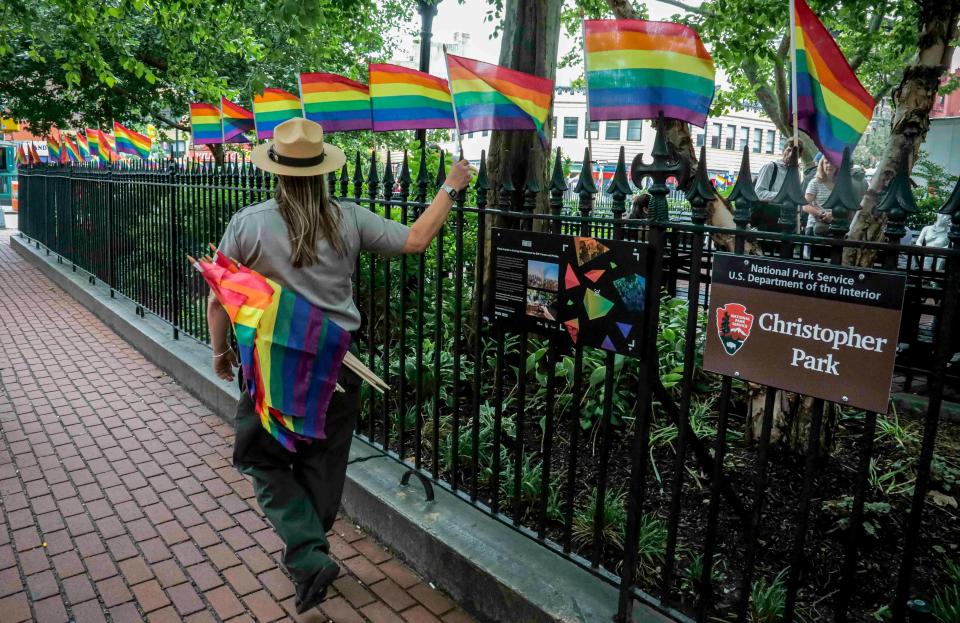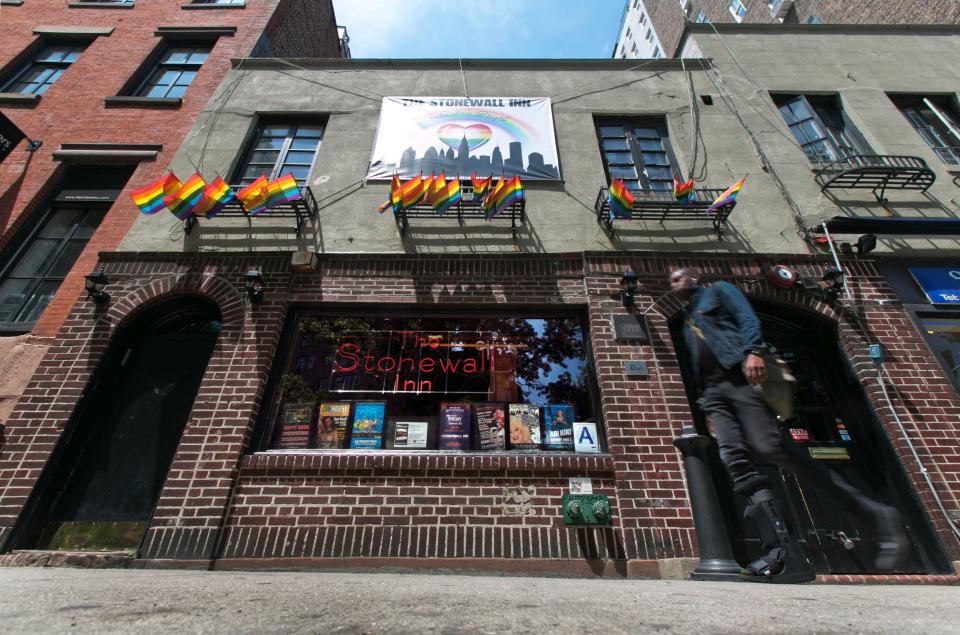It's officially Pride Month! Here's when and why we celebrate the LGBTQ community in 2023.
Pride Month is on the horizon as the weather begins to warm in the U.S., marking a time to celebrate LGBTQ communities, promote queer joy and fight for rights that are under attack.
New York hosts the country’s largest pride parades each year, and approximately 5 million people attended 2019 World Pride there, a global LGBTQ festival that marked the 50th anniversary of the 1969 Stonewall uprising.
Here’s everything you need to know about the upcoming 2023 Pride Month, including dates and a history lesson on the fight for LGBTQ rights.

When is Pride Month 2023?
Pride Month spans the month of June each year, this year beginning on Thursday, June 1 and ending on Friday, June 30. Pride celebrations – including parades, festivals, parties and picnics – are held throughout the month in different cities across America.
Here’s a glimpse at the dates and themes of some of the country’s biggest pride celebrations:
Provincetown, MA: June 2-4
Washington, D.C.: June 10. The 2023 theme is "Peace, Love Revolution."
Los Angeles: June 11 (Parade) and June 9-10 (LA Pride Festival). The 2023 theme is “All Out With Pride.”
Chicago: June 25 (Parade), June 17-18 (Chicago Pride Fest)
San Francisco: June 24 and 25 (Parade). The 2023 theme is “Looking Back and Moving Forward."
New York: June 25 (Pride March, PrideFest, Pride Island) and June 17 (The Rally). The 2023 theme is “Strength in Solidarity.”
Pride Month is here: Month comes as anti-LGBTQ bills make many states less equitable
What is Pride Month?
Pride Month commemorates the 1969 Stonewall Uprising in New York and celebrates the LGBTQ community and the fight for equal rights.
The Stonewall Uprising began on June 28, 1969, when police raided the Stonewall Inn, a prominent gay bar in Manhattan’s Greenwich Village. The subsequent protests over the next six days are credited with a shift in LGBTQ activism in the U.S.

The following year saw some of the first Pride parades in Chicago, San Francisco, Los Angeles and New York. Despite the pivotal role transgender people and women of color played in the riots, including trans activist Marsha P. Johnson, they were largely excluded from early Pride celebrations.
"The reality is that most of the folks on the front lines at the Stonewall uprising were trans women, trans women of color, other people of color, butch lesbians,” Cathy Renna, Communications Director for the National LGBTQ Task Force, told USA TODAY last year. “And yet somehow, the power that was coming together ... to put together Pride events was from cisgender, gay white men.”
Today, Pride Month symbolizes an opportunity for visibility and community. In addition to celebrating LGBTQ love and joy, it’s also often a time to highlight important policy and resource issues the community faces. In 2021, NYC Pride banned law enforcement presence at Pride events through 2025 because of escalating violence "against marginalized groups, specifically BIPOC and trans communities." And in 2023, LGBTQ organizations are combatting more than 650 anti-LGBTQ bills introduced this year.
History of Pride Month: In-depth look of how the LGBTQ celebration came to be
Rainbow capitalism: How corporate 'symbolic' LGBTQ pride can be harmful
When was Pride Month created?
The first Pride marches in New York, Los Angeles and Chicago happened on the one-year anniversary of the Stonewall Uprising, on June 28, 1970.
In New York, thousands marched from Christopher Street (where Stonewall is) to Central Park in what is widely considered the first Pride parade in the U.S.
But even before the first Pride parades, rumblings of the gay rights movement were happening all over the country. In 1950, for example, activist Harry Hay founded the Mattachine Society, the first national gay rights organization. And in 1955, the first lesbian rights organization, the Daughters of Bilitis, began.
The year 1965 saw the first “Reminder Day,” an annual picketing event outside of Philadelphia’s Independence Hall calling attention to the lack of civil rights for the LGBTQ community. In 1966, the Mattachine Society staged a “sip-in” at a Greenwich Village bar after the New York Liquor Authority banned serving gay patrons because they were “disorderly,” PBS wrote. And in 1966, there was the Compton’s Cafeteria riot, which began when a police officer manhandled a transgender customer at a San Francisco eatery. This led to the founding of the National Transsexual Counseling Unit. As the LGBTQ rights movement grew, the community turned away from outdated terms like transsexual and homosexual to transgender, gay and lesbian. While many consider these terms offensive, there are some who still use them to describe their identities.
The Christopher Street Liberation Day March on June 28, 1970, marked a shift from politeness to pride. In earlier protests, the “Homophile Movement” in the 1950s and 1960s focused on respectability – dressing in suits and skirts and carrying signs in protest. Post-Stonewall riots didn’t come with a dress code or tone requirement.
“A new spirit has entered the struggle for homosexual freedom – a new spirit both militant in tone and revolutionary in orientation,” a 1970 Gay Liberation Front flyer reads. “Homosexuals at last have realized that they will never be able to be liberated by politely asking the system. Freedom is never given – it must be taken.”
Stonewall generation: Post-Roe, LGBTQ community should 'be really afraid right now'
What does Pride stand for?
“Pride” itself does not stand for anything, but the LGBTQ community comprises several identities related to sexual orientation and gender identity.
Here are the definitions to know:
L: Lesbian
G: Gay
B: Bisexual
T: Transgender
Q: Queer, or sometimes questioning
+: Encompasses other identities under the rainbow umbrella
Dig deeper: Learn the meanings, origins of Pride flags
Pride Flag | Progress Pride Flag | Lesbian Pride Flag | Bisexual Pride Flag | Pansexual Pride Flag | Asexual Pride Flag | Intersex Pride Flag | Gender Identity Flags | Trans Pride Flag
This article originally appeared on USA TODAY: When is Pride Month 2023? Why the annual LGBTQ celebrations began

